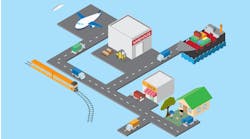Call it collaboration by coercion if you like, but shippers and consignees are learning that to keep rates in line—or even to get service—you have to become a more desirable customer. "The market has spoken," says Jim Applegate, National Logistics Management (NLM, www.nlmi.com). Sitting squarely between the shipper and the carrier, Applegate returned from the freight management company's annual meeting of motor carriers and shippers with an earful—well, both ears full—of issues and concerns from shippers, carriers and consignees.
The timing was right, because the latest numbers for logistics spending had just been released and, no surprise here, the trend is "up." Just how far depends on which logistics cost component you examine.
Year on year, the biggest increase comes in carrying costs. Interest costs alone rose 152% in 2005 to $58 billion; the highest since 2001. But interest rate increases aren't the sole culprit given that the 17th Annual State of Logistics Report, sponsored by the Council of Supply Chain Management Professionals (www.cscmp.org), covers 2005 and does not yet show some of the latest increases the Federal Reserve announced. Inventories are high, says Wilson. In fact, at $1,763 billion, inventories are at an historic high, unprecedented in the life of the State of Logistics Report.
Globalization is driving much of the demand and, according to John Manners-Bell from Transport Intelligence (www.transportintelligence.com), a U.K.based logistics consulting and research firm, demand for global transport may be driving ahead of the supply side's ability to invest in capacity. He points to Korean shipbuilders whose order books are full for the next three years and carriers who have continued to place orders for new, larger containerships.
Even a slowing of consumer demand in the U.S. has not had a significant impact on transport capacity demands and, continues Manners-Bell, the Trans Pacific Stabilization Agreement (TSA), a carrier conference, predicts strong demand and firm to higher prices through the third quarter. TSA is so confident in the strength of the pricing environment it announced it will add a surcharge of $400 per forty-foot-equivalent unit (FEU) for fuel.
All of this activity looks good for productivity figures, but that view may be misleading. With capacity lagging demand, capacity utilization can look pretty strong, but it doesn't speak to the congestion and infrastructure issues many in the logistics field are seeing. Four consecutive record years of double-digit growth means vessel space is tight, but with all of the demand placed on the logistics network, lagging terminal and rail improvements in U.S. ports rise to the top of shipper and consignee concerns.
In The State of Logistics Report Rosalyn Wilson notes the United States has not made sufficient investment to maintain and improve its aging transportation system.
"It can no longer meet the needs of the record-setting growth in freight flows," she says.
Wilson agrees with others when she observes, "We face capacity constraints at virtually all major freight gateways and congestion and bottlenecks throughout the system as it approaches full capacity."
This overtaxed network has helped carriers push rate increases and hold the line on assessorial charges and fuel surcharges. The number one reason NLM's Applegate was hearing for the capacity problems in motor carriage continues to be a driver shortage. It's a problem for long-haul truckload, he observes, but it is also affecting less-than-truckload (LTL) carriers.
The follow-on effects of the shortage has allowed carriers to go after the best shippers—those who pay well and on time and who have more desirable volumes and lanes. In shedding less desirable freight, carriers are looking at more than rates.
Is the customer easy to do business with, asks Applegate. What are payment terms and how are loading and unloading efficiencies? "Even with a good rate," says Applegate, "at the end of the day there are so many hidden costs in operating with some of these customers, and carriers are strategically placing their equipment in places that they can really get the best bang for their buck." This includes reexamining cross-border traffic. Border delays have become such an issue for some carriers that they are avoiding cross-border moves. With sufficient domestic freight to fill their trailers, many carriers see no negative effect on their revenues and a positive impact on efficiency and capacity utilization.
Behind the Capacity Crunch
Despite reports of some slowing of the U.S. economy, it looks like 2006 is shaping up to be another year of strong demand and limited capacity. Eric Starks from transportation forecasting firm FTR Associates (Nashville, Ind., www.ftrassociates.net) suggests capacity will remain tight through 2006 and into 2007. His research shows continued manufacturing strength.
Class 8 motor carrier capacity in use has been over 90% for the nine quarters through June 2006, says Stark. The historical average is 88%. In addition, total ton miles are expected to grow 2.1% in 2006 and the truck share of those ton miles will reach 44.8% in 2006 and 45.3% in 2007. With a driver shortage Starks estimates at 87,000, carriers have been able to hold rate increases, achieving a 6.6% average increase in 2005 on top of a 7.9% rise in 2004.
Rail capacity, especially intermodal, has gotten less attention than the trucking shortage, but the issue is real. Rates reflect this. Starks reports that rail users saw an 11.9% rate increase in 2005. Many shippers have voiced dissatisfaction with railroads, stating their rate increases are not justified by any improvement in service.
Starks points out that the U.S. gross domestic product (GDP) was up 3.5% in 2005 and is expected to rise 3.3% in 2006 and a slightly slower 2.9% in 2007. Tractor-trailer loads parallel overall economic growth and are expected to increase 2.9% in 2006 and 2.5% in 2007.
Rosalyn Wilson's prediction that logistics costs, as a percentage of GDP, would return to double digits for the first time since 2000 was not realized in 2005, but she is certain the rise to 9.5% in 2005 will lead to a 10+% figure in 2006.
International Growth
Spending on international ocean carriage increased 7% in 2005 to $29 billion. But from 2003, the increase was 38%. Taking a slightly longer view, spending for international ocean rose 61% since 2000. The picture for international air shipments is even more dramatic.
Spending rose 15% in 2005 to $15 billion, up 88% from 2003. Spending on freight forwarders and other services increased 22% in 2005 to $22 billion, bringing the total to $66 billion for the three categories, an $8 billion increase or 13% from 2004.
After chugging along in the mid $30 billion range for years, rail spending jumped to $48 billion in 2005. The five-year trend in spending for intercity motor carriage has generally floated around the lower $300 billion range. The lowest costs since 2000 were in 2002, when spending for intercity motor carriage was $300 billion. The slow rise to $315 billion the following year and $335 billion the year after turned into a more rapid increase, achieving $394 billion in 2005.
Wilson's report points to the connection between international and domestic transport networks as a critical bottleneck that shows signs of getting worse. On the port side, only three North American ports handled over 2 million containers per year prior to 2004. Based on 2005 figures, 10 ports handled over 1 million containers. Growth rates for some of those ports are over 20% from 2004 to 2005, and volumes have continued to increase.
"Many ports also suffer from congested truck and rail access routes and severe space limitations on available land around ports," says Wilson. New cranes, new equipment, expanded roads and rail access all figure into many ports' nearterm plans to mitigate some of the congestion. More ports are also adopting extended gate hours to shift more work to off-peak periods and ease some of the impact of road congestion in the vicinity of the port. But all of this, says Wilson, is still not enough.
"The dramatic growth in the volume of freight moving in our logistics system has severely strained the transportation network in some locations. The increase in international trade has placed mounting pressure on the initial points of entry —the gateways, ports, airport and border crossings—creating bottlenecks for the movement of freight," Wilson says in her call for "strong leadership" that would identify priorities and develop and commit resources to implement a plan for investment in needed upgrades in infrastructure.
Capacity, measured in terms of workers, infrastructure or equipment, is not keeping pace with growth in volume. Many shippers have pre-booked equipment for the peak shipping season, exacerbating the capacity problem for others. With little to indicate a dramatic change from this condition through the end of 2006 and into 2007, the message to shippers and consignees is clear—work collaboratively to maintain efficiency and keep costs out of the process and you are more likely to find willing carriers.
Warehousing and Inventory Costs | ||
| 2005 ($ billions) | Annual growth | |
| Interest | 58 | 152% |
| Taxes, obsolescence, depreciation, insurance | 245 | 6% |
| Warehousing | 90 | 10% |
| Total | ||
| Transportation Costs ($ billions) | ||
| Intercity motor carriage | 394 | 18% |
| Local motor carriage | 189 | 9% |
| Rail | 48 | 14% |
| Water, domestic | 5 | 0% |
| Water, international | 29 | 7% |
| Air, domestic | 25 | 19% |
| Air, international | 15 | 15% |
| Oil pipeline | 9 | 0% |
| Forwarders and other services | 22 | 22% |
| Total Transportation | 736 | 14% |
| Other Logistics Costs ($ billions) | ||
| Shipper-related costs | 8 | 0% |
| Distribution administration | 46 | 18% |
| Total | 54 | 15% |
| Total U.S. Logistics Costs | 1,183 | 15% |
| Source: State of Logistics Report | ||


